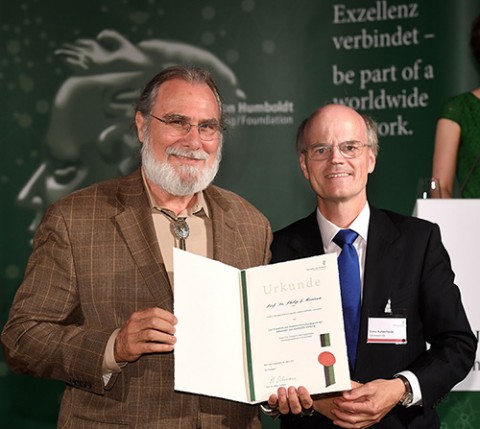 |
| Phil receiving the Carl Friedrich von Siemens-Forschungspreis der Alexander von Humboldt-Stiftung in Schloss Charlottenburg, Berlin July 7, 2016. |
Philip Morrison first studied German as an undergraduate because he wanted to read physics papers by Max Planck in the old German typeface.
"Although English is now the international language of physics," Morrison said, "I have been brushing up on German with the hope of becoming fluent during my upcoming year at the Max Planck Institute."
Professor Morrison, a professor of physics and a member of the Institute for Fusion Studies at UT, recently won the Carl Friedrich von Siemens Humboldt Research Award, which is a prize granted by the Alexander von Humboldt Foundation in acknowledgement of a researcher's entire body of work. As an award winner, Prof. Morrison has been invited to spend time abroad in Germany to collaborate on long-term projects with specialists at German research institutions.
Prof. Morrison began his academic career at UT in 1981 as an assistant professor and as a research scientist at the Institute for Fusion Studies, a group that concentrates on theoretical plasma physics of magnetic confinement fusion. Prof. Morrison said his interest in physics began at an early age.
"It was never a question of what are you going to be when you grow up," Prof. Morrison said. "I've been asking questions about everything from number sequences to circuits from a very early age."
A San Diego native, Morrison attended the University of California at San Diego for his undergraduate studies all the way through his PhD. After spending two years at Princeton as a postdoctoral fellow, he came to the University of Texas in 1981 and it has remained his home ever since. Prof. Morrison has spent a significant amount of time abroad, as a visiting researcher and professor in England, France, Brazil, and Germany, as well as having a few visiting positions in the US.
Prof. Morrison is a mathematical physicist who often works closely with plasma physics, but also has broad, interdisciplinary interests. Prof. Morrison is primarily a dynamicist, meaning that he is more interested in how things move around, rather than reactions and constituents as in nuclear or particle physics. As a dynamicist, he aims to predict the future using current states of matter.
"One finds that there are certain geometric structures that are very intriguing, that I like to study," Prof. Morrison said. "It's like watching a turbulent brook, if you're backpacking somewhere, and you see the water swirling around, and where it goes I've always found it captivating."
Prof. Morrison considers himself a skeptic by nature. He said he enjoys mathematics, and likes to examine the interplay between theorems and algorithms to illuminate physical laws.
"I live in the gap between physics and mathematics," Prof. Morrison said. "Sometimes I like to get very close to data. Truth is important, and math is a kind of truth."
Dr. Harry Swinney, a professor of physics at UT's Center for Nonlinear Dynamics, has worked with Dr. Morrison for over three decades. Dr. Morrison and his students develop mathematical theory, and Dr. Swinney and his students conduct experiments to test those theories
"We have had fun examining problems such as how planetary jets like the Gulf Stream and the atmospheric jet stream act as barriers to heat, nutrients, and pollutants," Dr. Swinney said. "[Dr. Morrison] is also interested in the nuts and bolts of experiments. He's a guy who does his own plumbing rather than calling the plumber."
As a mathematical physicist, the kind of work that Prof. Morrison has been able to do has changed as technology has progressed. When he was a graduate student, scientists were still uploading computer programs on punch cards. But now, Prof. Morrison has enormous computing power at his fingertips to work on his algorithms for solving equations.
"You can get stuff out of the computations that tell you, 'Ah, that's what's going on!'" Prof. Morrison said. "You can then go back to the calculations and see that what the computer is showing you was in the equations, we just didn't know how to find it."
In dynamics, physicists take models and attempt to discover what the model equations say. The solutions are often so complicated that they cannot simply be written down. For Prof. Morrison, one challenge is figuring out how to put models on computers and get answers.
"Putting a model on a computer involves creating numerical algorithms, and to preserve important structures you need to build the physics into the way the algorithm works," Prof. Morrison said. "With this prize money, I'll be able to go to Germany and work with fellow scientists including Prof. Sonnendruecker, who is an expert in numerical algorithms and is the Director of the Numerical Plasma Physics Division of the Max Planck Institute near Munich."
This article was written by Physics Department interns Megan Kallus, a junior English major, and Max Parks, a fifth-year Physics and Astronomy student.





